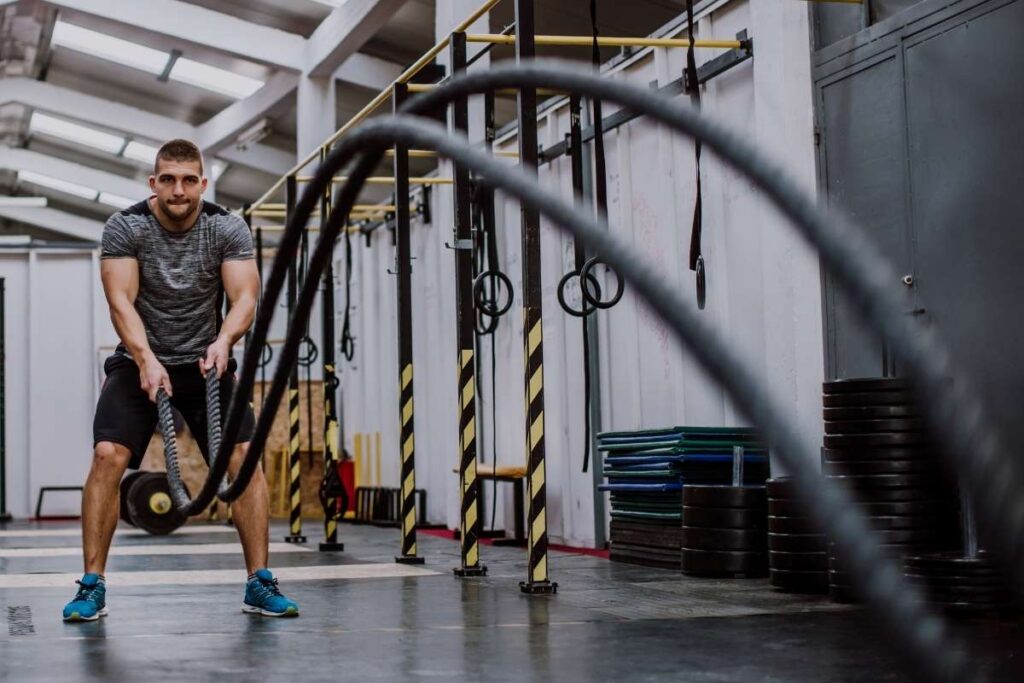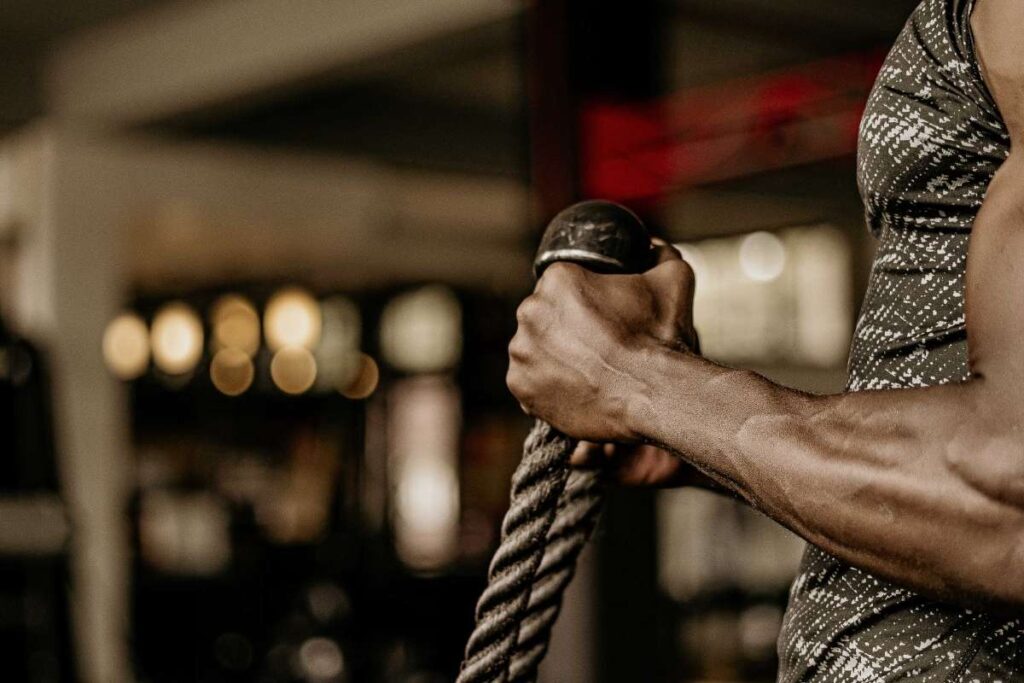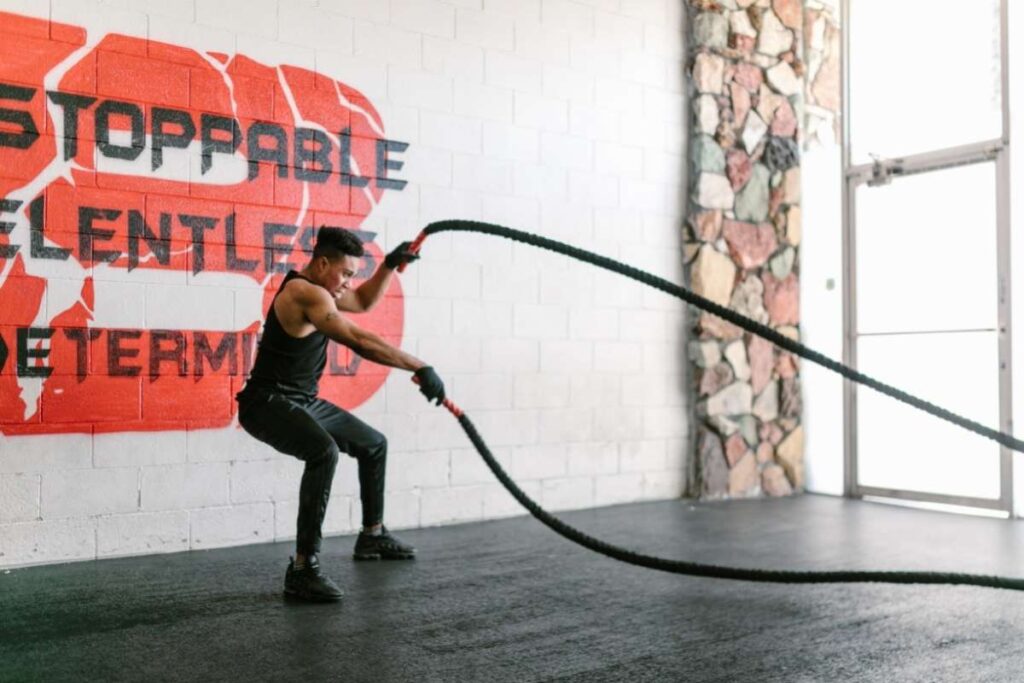This post may contain affiliate links at no additional cost to you. As an Amazon Associate I earn from qualifying purchases. Click to view our full disclosure.
What's inside
While exercise equipment like free weights and machines have dominated the gym space for decades, newer forms of workout gear are always being added.
Adding novelty to your workout with different equipment and training methods has tons of benefits. That said, some devices are more effective than others.
One of the more popular training methods seen in the fitness world in recent years is the battle rope.
This article will cover why battle ropes are a great addition to your program, how to use them, and some of the best battle rope exercises to get started with.
I’ll even share a battle rope workout plan you can try for yourself. Keep reading for instructions, tips, and more.
What are battle ropes?

Battle ropes are a strength and conditioning tool, consisting of a (most often) 40mm-thick rope with rubber-capped ends.
Battle ropes come in different lengths and materials for durability in indoor and outdoor settings.
The basic premise behind training with battle ropes is anchoring the ropes to a set point and using one or both limbs to move the ropes in different ways.
Battle ropes are commonly used for muscle endurance work and are utilized in many different sports and training styles.
What are battle rope exercises good for?

Battle rope training has many physical and psychological benefits for both athletes and general fitness enthusiasts.
They have the ability to get the heart rate up very quickly and are used as a high-intensity method of training.
Battle rope exercises can be good for cardiovascular conditioning and upper body endurance, as well as core and lower-body strengthening and stability.
Certain battle rope exercises can also be used to develop functional, explosive power in athletic movements. This translates well to various sports-specific moves.
What muscles do battle ropes work?
Battle ropes can be used to provide a whole-body workout in combination with certain exercises.
While the arms may be seen as doing the bulk of the work in many battle rope exercises, the trunk and lower body are still heavily involved.
In typical battle rope exercises, the anterior deltoids, biceps, and forearms lift the ropes. Meanwhile, the upper and lower back, glutes, core, and legs stabilize the body.
Certain moves with the battle ropes will target muscles differently while providing a high-intensity stimulus to the cardiopulmonary system.
Take a look at our battle rope workout (beginner and advanced variations) below to get an idea of how to hit the entire body with the ropes.
How long should beginners do battle rope exercises?
Anyone who has tried a battle rope workout knows that it is a very taxing form of training.
Training with battle ropes is not for the faint of heart and should be undertaken with care.
A battle rope workout for a beginner should consist of short bursts of activity with sufficient rest breaks for recovery.
Initial bouts on the battle ropes can be as short as 10 seconds, with longer rest breaks between rounds.
Even at the higher end of battle rope training, sets won’t often go beyond 30 seconds, as local muscle fatigue will stop you – if you don’t get gassed first.
What are the benefits of doing battle rope exercises?

There are many physiological benefits to adding a battle rope workout into your fitness routine.
One study found battle rope workouts helped build upper body power and shooting accuracy in basketball players.
Other research showed battle rope exercises helped increase grip strength and create symmetry between sides.
Still, further investigation claimed battle rope workouts helped youth boxers develop arm strength and muscular endurance.
In addition to these more specific muscular benefits, battle rope workouts are simply a quick and effective conditioning session – and they’re fun!
When are battle rope exercises used?
HIIT
Battle ropes are a great way to get a fast but intense conditioning session in.
With a few short rounds, the battle ropes will have your heart rate sky-high.
Battle rope exercises also make a great addition to a varied circuit plan, which would include other exercises and equipment.
Warm-Up
Battle ropes can be used to get the heart rate up and warm up the arms and shoulders before a weight training session.
A few sets of waves, claps, and circles can quickly prime the shoulders, elbows, and wrists for further work to come.
Workout Finishers
If you’ve completed your primary exercise but feel like you haven’t had your butt kicked enough, a couple of rounds of battle rope exercises will do the trick.
Even as little as a few minutes of battle rope moves done intensely will have you crawling out of the gym in a puddle of sweat (if that’s what you’re into).
Stand-Alone Workouts
If battle ropes are all you have on hand, you can still get a great full-body workout in.
Check out the workouts below for just a couple of examples of how to train for strength, endurance, and conditioning using just the battle ropes.
How to Use a Battle Rope

Battle ropes look easy enough to use – just pick them up and start swinging, right?
Although simple to get into, battle rope exercises can still cause injury if not used correctly.
The long and heavy ropes can easily pull you off balance and cause strain to the tissues of the shoulders and lower back.
Be sure to pick up the rope handles with a good squat stance, lifting with a straight back.
Also try to keep the rope handles close to the body, except where directed in an exercise.
Main Grips Used to Perform Battle Rope Exercises

Neutral
The most common grip for handling the battle ropes is a neutral, or “hammer” grip.
This involves grabbing the ropes with the palms facing each other.
You can wrap the thumb around the rope or align the thumb up the rope depending on personal preference.
Overhand
Some exercises call for an overhand grip on the rope with the palms facing down.
For example, some exercises use the battle rope while in a push-up position, with the hands over the ropes while supporting the body weight.
Underhand
Underhand grips allow you to work different muscles in the forearms and upper limbs during battle rope exercises.
An underhand grip can be simply holding the ropes palms-up, or by holding the handles from the underside, with the handles facing up rather than back.
Now we’ve covered how battle ropes work and why they’re a great tool, let’s look at some of the best battle rope exercises you can do.
12 Best Battle Rope Exercises to Include in Your Workout Program
Related: How Many Exercises Per Workout?
1. Alternating Waves
The quintessential battle rope exercise, the wave is a great place to start for those getting into battle ropes.
While simple to pick up, this exercise will get hard quickly, so start slowly and build up over time.
Equipment Requirements: Battle ropes, anchor point
How to Perform Alternating Waves:
- Stand with feet shoulder-width apart, holding ropes
- Bend knees and hips slightly, sitting back into heels
- Alternate hands up and down as quickly as possible
- Release the ropes safely at set completion
Benefits: Easy to learn, fundamental battle rope movement
Pro Tips: Experiment with wave size and speed to feel different effects in your workout
2. Claps
Claps provide the same stability and conditioning benefits as waves while providing different movements at the upper limb.
Equipment Requirements: Battle ropes, anchor point
How to Perform Claps:
- Stand in same starting position as above – feet shoulder-width apart
- Brace the midsection and hold the ropes on the outside
- Clap the hands in and out as fast as possible
- Finish time or reps and release
Benefits: Targets the pecs, rear delts, and serratus anterior
Pro Tips: Press with the heel of the palm for a smoother swing
3. Slams
Slams are an incredible high-intensity conditioning exercise, great for building power in the shoulders while getting a killer cardio workout.
Equipment Requirements: Battle ropes, anchor point
How to Perform Slams:
- Pick up ropes with overhand grip and stand straight
- Squat down slightly with hands on either side
- Stand up quickly while lifting the ropes overhead
- Squat down as you drive the ropes downward hard
Benefits: Excellent for developing power through the midsection
Pro Tips: Keep the grip neutral or underhand if you experience shoulder impingement issues
4. Seated Waves
If you want a greater challenge for your core muscles, try this seated variation of waves.
This variation also provides a great active stretch for your adductors to improve lower body flexibility.
Equipment Requirements: Battle ropes, anchor point
How to Perform Seated Waves:
- Sit straight with the legs wide on either side of the ropes
- Straighten the back and brace the core
- Perform alternating wave movement as above
Benefits: Builds the obliques for rotational strength and to protect the low back
Pro Tips: Always work to sit straight and tall, don’t let the back round
5. Squat Hold Waves
While the arms take care of the battle ropes, challenge your quads and glutes with this isometric lower body hold.
Equipment Requirements: Battle ropes, anchor point
How to Perform Squat Hold Waves:
- Assume the starting position of conventional waves
- Squat as low as is comfortable, holding this position
- Perform the desired time or repetitions
- Stand up and shake the legs out between sets
Benefits: Builds isometric strength in the bottom squat position, a weak point for many lifters
Pro Tips: Experiment with different stances to target the glutes, adductors, or quads
6. Side-to-Side Slams
Another great athletic movement, the side slam transfers energy from one foot all the way to driving through the arms.
Equipment Requirements: Battle ropes, anchor point
How to Perform Side-to-Side Slams:
- Stand with the knees slightly bent, loading one leg with the opposite toe pivoted
- Hold the ropes on the stance leg side at mid-thigh level
- Drive through the foot to lift the ropes up and over in an arcing motion
- Pivot the foot to end up in the starting position on the other leg
Benefits: Athletic movement for contact or combat sports
Pro Tips: Keep the hands pressed together to draw more strength from the ground up
7. Jumping Slams
Jumping slams are one of the most intense battle rope exercises, adding explosive leg work to an already challenging movement.
Equipment Requirements: Battle ropes, anchor point
How to Perform Jumping Slams:
- Start in the regular slams position with the ropes at either side
- Squat down, then quickly explode into a jump
- Lift the ropes overhead and slam them down while landing the jump
- Repeat for reps as quickly as possible
Benefits: Develops explosive strength and endurance
Pro Tips: Coordinate the legs and arms to avoid leaking power
8. Standing Twists
The battle rope version of a Russian twist, this exercise keeps you on your feet for a more functional core rotation movement.
Equipment Requirements: Battle ropes, anchor point
How to Perform Standing Twists:
- Stand with a wide stance, with the rope handles in front of the torso
- Bending the knees slightly, brace the trunk as you turn
- Pull the ropes with the hands together side to side
Benefits: Another core builder for rotational development for sport or everyday life
Pro Tips: Sit into the hips to draw power from the glutes and protect the back
9. Reverse Lunge Waves
While moving the rope, you can also throw in traditional bodyweight exercises like the reverse lunge.
This combo is amazing for building your balance and coordination while getting your conditioning work in.
Equipment Requirements: Battle ropes, anchor point
How to Perform Reverse Lunge Waves:
- Stand with the feet hip-width apart and the ropes in front of the body
- Begin performing alternating waves with the ropes
- At the same time, step one foot back and drop the back knee down
- Drive up to the starting position and repeat with the other leg
Benefits: Combination exercise, great for coordination and balance
Pro Tips: Keep your feet hip-width apart when stepping back for better balance
10. Underhand Waves
To focus a little more on the biceps, try this underhand version of the staple battle rope exercise.
It also serves as a slight break from some of the more dynamic and taxing battle rope movements in this list.
Equipment Requirements: Battle ropes, anchor point
How to Perform Underhand Waves:
- Assume a wide and low battle rope wave stance
- Hold the ropes with the palms facing up and the elbows locked to the sides
- Perform waves with minimal movement of the upper arm
Benefits: Isolates the biceps more than the anterior delts for a different target muscle
Pro Tips: Think of drawing small circles toward yourself to feel a great bicep pump
11. Plank Waves
Another combo exercise, this move puts you in a push-up (or straight-arm plank) position while handling the ropes.
This exercise will kill your core, shoulders, and quads – and gas you at the same time.
Equipment Requirements: Battle ropes, anchor point
How to Perform Plank Waves:
- Start in a full push-up position, holding the rope handles in each hand
- One arm at a time, support yourself while performing waves with one hand
- Perform desired set on one side then repeat with the other arm
Benefits: Builds core strength and shoulder stability against perturbations
Pro Tips: Don’t let the rope work make you forget that this is still a plank!
12. Circles
Related: Ultimate Cable Shoulder Workouts
Finishing off this list, shoulder circles will build strength and stability in the shoulder joints.
You can perform circles in either direction, depending on which muscles you want to strengthen around the shoulders.
Equipment Requirements: Battle ropes, anchor point
How to Perform Circles:
- Stand in a similar stance to performing regular rope waves
- Drive through the feet as you begin swinging the ropes in circles
- Start small and build to the biggest circles possible
- Perform circles inward or outward as prescribed
Benefits: Develops the smaller supporting muscles in and around the shoulder joint
Pro Tips: Squeeze the shoulder blades back and down to avoid uncomfortable positions
The Best Battle Rope Workout Program

The following workouts put the above exercises together for some whole-body, high-intensity training sessions.
These sessions can take as little as 15-20 minutes, but you’ll be happy about that once you try them.
The beginner workout is shorter bouts of work, using some of the simple but effective battle rope exercises.
The advanced version uses Tabata-style intervals of 20 seconds work, 10 seconds rest.
This will really challenge your cardio fitness as well as your upper body endurance.
Perform these workouts up to 4-5 times per week, or just as in-between cardio sessions for your weight training program.
Beginner
| Exercise | Sets x Reps | Rest |
| Circles | 3×10 sec | 20-30 sec |
| Claps | 3×20 sec | 20-30 sec |
| Seated Waves | 3×10 sec | 20-30 sec |
| Slams | 3×10 sec | 20-30 sec |
Advanced
| Exercise | Sets x Reps | Rest |
| Iso Squat Waves | 8×20 sec | 10 sec |
| Standing Twists | 8×20 sec | 10 sec |
| Jumping Slams | 8×20 sec | 10 sec |
| Plank Waves | 8×20 sec | 10 sec |
Tips for Getting the Best Results From Battle Rope Exercises

Simply getting in and giving these exercises a try will add a novel and effective method of training to your routine.
That being said, here are a few tips to help you get the most out of your battle rope workout.
Breathe
Whipping the battle ropes takes a lot of bracing through the core, and it’s easy to hold your breath.
Practice controlled breathing in through the nose and out through pursed lips during your rope intervals.
In addition, take nice deep breaths in your rest breaks, arming yourself with as much fresh oxygen as possible for the next round.
Rope Length
While most battle ropes range from 9 to 15 meters in length, you can adjust your position relative to the anchor point.
Standing closer to where the battle ropes are attached decreases the resistance, making it easier on your arms.
For a greater challenge, stand as far back as possible and try to perform your waves without the rope touching the ground.
Adjust Grip
Related: A Detailed Guide To Hook Grip Deadlift
While certain exercises may require a specific grip functionally, don’t be afraid to experiment with what works best for you.
If you have any issues with grip strength, wrist, or finger pain, try different grip positions to see what gives you the strongest hook on the ropes.
Other aids like gloves or liquid chalk can help you get a good hold as you perform your battle rope exercises.
Arm Position
Battle rope exercises put a lot of force through the shoulder joint.
While this is great for building stability and endurance through the shoulder, some people with poor mobility or past injuries might find some exercises uncomfortable.
Adjust your grip and keep the elbows as close to the body as you can to avoid aggravating any shoulder issues you may have.
If you’re unsure, consult an exercise professional before adding battle ropes to your routine.
Programming
As a high-intensity workout, battle rope exercises are best done at specific times during your training schedule.
For example, if you have a heavy arms, chest, or shoulder workout coming up, gassing your upper limbs with a rope session might not be the best idea.
Be smart about where you add your battle rope work into your overall training plan.
Warming Up
Although battle rope workouts can be performed as a warm-up themselves in some cases, don’t just pick up the ropes and start slamming.
Whether it’s a general warm-up, some specific shoulder work, or just easing into the simpler battle rope exercises, always prep your body for the intense stuff.
Technique
Battle rope exercises can look pretty rapid and wild when viewed from the outside.
That being said, there is still a right and wrong way to perform these exercises, and there are surely a few shoulder injuries out there to prove it.
Follow the technique points listed in this guide, and have a professional check out your form if necessary to avoid any training mishaps.
Mental Fortitude
A battle rope workout may be short, but it’s tough. This style of training requires the type of grit not everyone possesses.
Use the battle rope to build your ability to hang in there for those last few seconds, and you’ll find a positive carryover into other aspects of life.
Final Thoughts
So, what did you think of our guide to battle rope training? We hope you found some useful tips and that you’ll give battle rope workouts a try.
Let us know your favorite battle rope exercises – and if you survived the example workouts – in the comments.
If you know anyone thinking of getting a battle rope – or wondering how to use the ones in their gym – share this article with them as well.
Frequently Asked Questions
How long should battle rope exercises be?
When performed correctly, battle rope exercises are very intense. This means they can usually only be maintained for about 10-30 seconds.
A set of a battle rope exercise should only last as long as you can maintain safe form, however.
Start with short bouts of up to 10 seconds, and build your ability from there.
Is it OK to do battle ropes every day?
For experienced trainees who have used battle ropes for a long time, a small amount of battle rope training can be incorporated daily.
However, overtraining of the shoulders or excessive strain to the lower back, are potential consequences of doing too much battle rope work too frequently.
Use soreness, energy levels, and your other training to dictate how often you attack the battle ropes.
Are battle ropes good for losing belly fat?
Studies on battle rope training have shown that it is as effective as other forms of high-intensity cardiovascular work.
This is in terms of both aerobic conditioning, as well as calorie-burning potential.
Of course, exercise is only a small piece of the puzzle when it comes to losing belly fat, so be sure your diet is also on point if that is the primary goal.
Does battle rope build muscle?
Battle ropes have a lot of benefits in terms of building strength and muscle, in an athletic, functional way.
That being said, the style of training done with battle ropes is definitely not the predominant way to build muscle mass.
Proper resistance training should be the main aspect of a muscle-building program, with battle rope workouts used as supplementary training.

